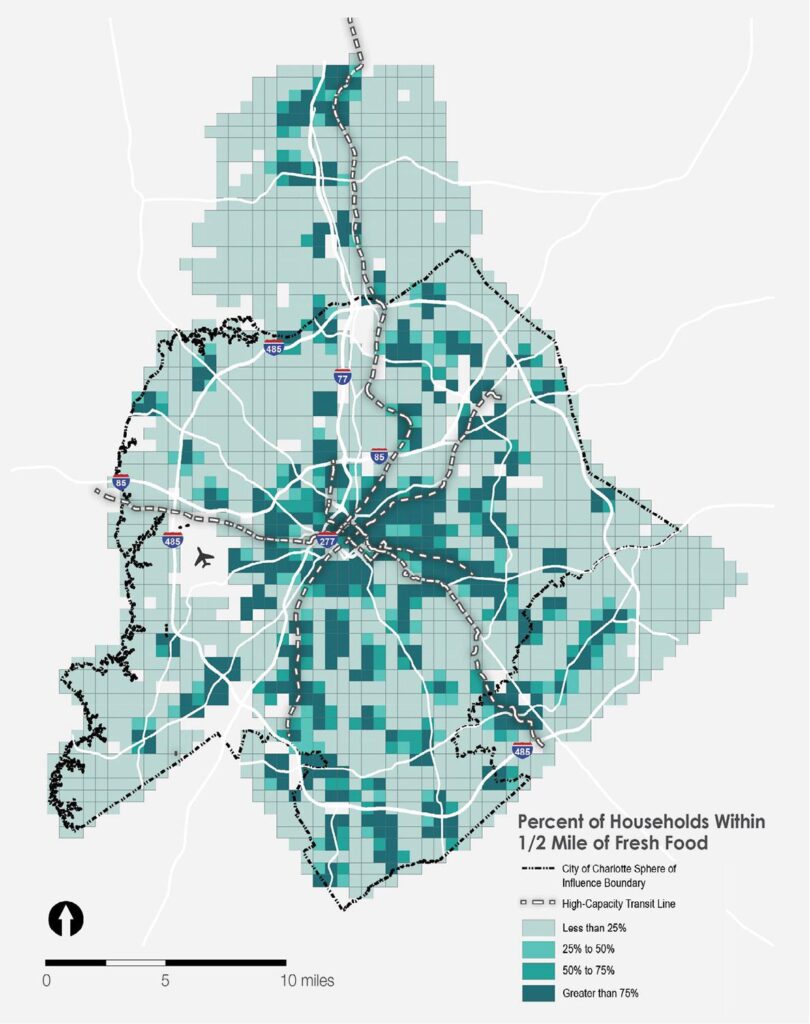Home / A. Equitable Growth Framework Manual / Equity Metric #1: Access to Essential Amenities, Goods and Services
Manuals and Metrics
Table of contents
Equity Metric #1: Access to Essential Amenities, Goods and Services
Building on the Equity Atlas developed in Phase 1 of the Comprehensive Plan effort, a methodology for measuring access to essential amenities, goods and services has been developed to help identify areas where residents and businesses may not have access to essential amenities, goods and services. The measuring of access to essential amenities, goods and services is closely linked to the bigger Plan concepts related to complete communities and 10-minute neighborhoods. The metrics to measure access to essential amenities, goods and services will primarily utilize data associated with the Charlotte/Mecklenburg Quality of Life Explorer (QLE) tool that looks at the social, housing, economic, environmental and safety conditions in Charlotte and Mecklenburg County. The following measures are proposed to measure access to essential amenities, goods and services.
Access to essential amenities, goods and services is analyzed using seven measures:
- Proximity to Childcare and Early Childhood Education;
- Proximity to Parks, Open Space and Trails;
- Proximity to Community Facilities;
- Proximity to Fresh Food;
- Proximity to Health Care & Pharmacies;
- Proximity to Financial Services; and
- Access to Internet Service.
Data: Grid cells that meet the “opportunity” criteria for each of the 7 metrics are scored with a 1, while those that do not meet the criteria receive a 0. Scores are added to create a final Access to Essential Amenities, Goods, and Services score. The primary housing data source is Mecklenburg County tax parcel data (2019). Data is reported at the parcel level and aggregated to grid cells based on the centroid location of the parcel. The amenities, good and services data is from a variety of sources and is outlined in the data inventory.

Proximity to Childcare and Early Childhood Education
This measure examines proximity of households across Charlotte to licensed childcare/early childhood education facilities. Areas with more than 50% of households within ½ mile of a licensed childcare/early childhood education facilities are considered to have equitable access.
Map below: Percentage of Households within ½ mile of Licensed Childcare/Early Childhood Education Facility

Proximity to Parks, Open Space and Trails
This measure examines the proximity of households across Charlotte to outdoor recreational opportunities. Areas with more than 50% of households within ½ mile of parks, greenway, open space or trails are considered to have equitable access.
Map below: Percentage of Households within ½ mile of Parks, Open Space and Trails

Proximity to Community Facilities
This measure examines the proximity of households across Charlotte to community facilities and amenities. Areas with over 50% percent of households within ½-mile of libraries, recreation centers, senior centers, nature centers, or indoor rental facilities are considered to have equitable access.
Map below: Percentage of Households within ½ mile of Community Facilities

Proximity to Fresh Food
This measure examines the proximity of households across Charlotte to healthy, fresh food options to assess equitable access. Areas with more than 50% of households within ½ mile of grocery stores, farmers markets, or community gardens are considered to have equitable access.
Map below: Percentage of Households within ½ mile of Fresh Food Options

Proximity to Health Care & Pharmacies
This measure examines the proximity of households across Charlotte to health care facilities and pharmacies. Areas with more than 25% of households within ½ mile of a healthcare facility and a pharmacy are considered to have equitable access.
Map below: Percentage of Households Within 1/2 mile of Health Care Facilities and Pharmacies

Proximity to Financial Services
This measure examines the proximity of households across Charlotte to banks and credit unions. Areas with more than 50% of households within ½ mile of a bank or credit union are considered to have access to financial services.
Map below: Percentage of Households Within 1/2 mile of a Financial Institution

Access to Internet Service
This measure examines the percentage of households across Charlotte with internet connectivity. Areas with more than 75% of households with internet access are considered to have equitable internet access.
Map below: Percentage of Households with an Internet Subscription

